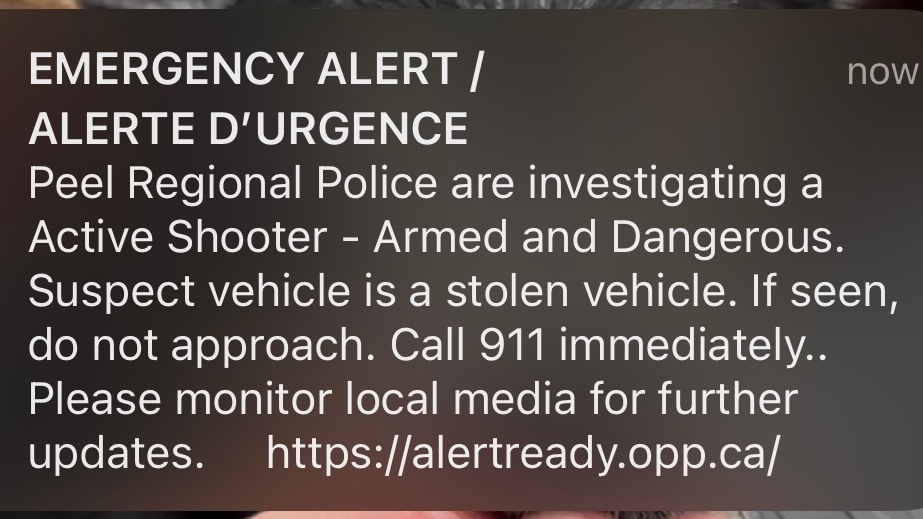On Monday, as an active shooting situation unfolded across the Greater Toronto and Hamilton Area, a public emergency alert was issued to all wireless devices in the region.
The alert warned those in the GTHA that Peel Regional Police were investigating an active shooter considered armed and dangerous, and that the suspect was in a stolen vehicle.
“If seen, do not approach. Call 911 immediately,” it said.
The alert did not provide information on the vehicle make or model, and it did not provide a suspect description. While it contained a link to more information, many reported the link landed them on an error page.
The incident took the lives of Toronto Police Constable Andrew Hong and Milton auto body shop owner Shakeel Ashraf, left a 28-year-old student on life support, and injured two others. Over the course of the rampage, the shooter, identified Thursday as 40-year-old Sean Petrie, drove from Mississauga, to Milton, and then to Hamilton, Ont., in a black Jeep Cherokee.
Not long after the alert was issued, Hamilton police announced they’d taken Petrie into custody. He was killed during the interaction, ending the threat to public safety.
Many recipients of the public emergency alert have been quick to point out the lack of detail included in it – namely, a description of the suspect, the make or model of the vehicle, or an indication of where the events were unfolding within Peel region.
Officials have also faced criticism for the timing of the alert, issued at 4:23 p.m. – nearly two hours after Hong had been shot.The alert could have caused some to interpret the events were unfolding in Peel region at this time, when, in reality, Petrie would be arrested Hamilton minutes later.
 Emergency public alert issued on Sept 12.
Emergency public alert issued on Sept 12.Dr. Terry Flynn, an associate professor of communications management at McMaster University, acknowledged that police forces are faced with a difficult challenge when it comes to communicating information to the public in a situation as fluid as an active shooting. Yet, he says Monday’s alert lacked a meaningful call to action.
“Okay, so there’s an active shooter – different people have a different concept of what kind of action to take,” Flynn said in an interview Thursday. “So the criticism is, what was the direction? What was the meaningful action that people should’ve taken?”
He also noted the alert urged those who may have seen the suspect vehicle to call 911, but lacked a description of that vehicle, save that it had been stolen.
“It didn't say anything about what kind of stolen vehicle or where it was headed, so I don't know how to differentiate whether [a vehicle] is owned, leased or stolen,” he said.
At a news conference Thursday, Peel Regional Police Chief Nishan Duraiappah said the alert couldn’t have been sent any sooner, and that police needed to confirm the shootings were connected before it could be issued.
“I can allay any concerns that [the alert] was delayed,” Duraippah said. "As soon as we were able to extrapolate that there was multiple [connected] incidents happening, it went through the immediate process."
In response to critiques of a lack of vehicle description or location, the chief said these details weren’t confirmed at the time.
“The purpose of the alert is because we don't know where he is, we don’t know if the vehicle’s changed,” he said.
“To those people who may be frustrated with the absence of detail in it: if we had a detail, we would put it out. If we had more detail, we may not have even issued the alert, we would have probably gone right to the subject.”
Duraippah said the alert ultimately achieved its goal.
“If somebody listens to that alert, shelters in place, and it mitigates the loss of one life, we've achieved our purpose.”
While Flynn says Monday’s alert did its primary job – getting the public’s attention – he worries the population could become desensitized to public emergency alerts system if too many are discredited or dismissed.
“You want a system that is timely, informative, and action oriented – these are the three components you need for these alerts to be meaningful, and so that people don't don't discredit that as a form of notification,” he said.
“You're not going to get a one size fits all for everybody, [..] and I'm not trying to, in any way, shape or form, criticize those decisions in the moment, but we need to find better ways to utilize this [system] before it becomes useless.”
CIVIL EMERGENCY PUBLIC ALERTS
Active shootings fall under the category of civil emergencies in the National Public Alerting System -- a category that historically not often been issued in Canada, Flynn says.
According to the framework, this alert is issued when humans cause a disruption of services or require varying levels of support, law enforcement or attention.
After the 2020 Nova Scotia massacre, Canada's deadliest mass shooting, which claimed 23 lives, RCMP faced severe criticism for failing to issue a public alert.
More recently, the system was used to aid officers in their search for Myles and Damien Sanderson, suspects in a series of stabbings at James Smith Cree Nation and in Weldon, Sask.
In this instance, the alert was issued in Manitoba, Saskatchewan, and Alberta, and included a vehicle description.

Post a Comment